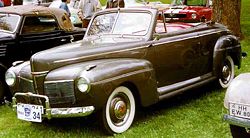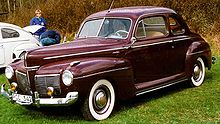Mercury (Eight)
| Mercury Eight | |
|---|---|
| Production period: | 1939-1951 |
| Class : | upper middle class |
| Body versions : | Sedan , station wagon , coupé , convertible |
The Mercury (unofficially called Mercury Eight to differentiate it from other models ) was the first passenger car manufactured by Mercury , a brand of the Ford Motor Company . It was built from 1939 to 1942 and from 1946 to 1951.
Series 99A and 09A (1939-1940)
| 99A / 09A | |
|---|---|
|
Mercury Series 99A |
|
| Production period: | 1939-1940 |
| Body versions : | Sedan , coupe , convertible |
| Engines: |
Otto engine : 3.6 liters (70 kW) |
| Length: | 4559 mm |
| Width: | |
| Height: | |
| Wheelbase : | |
| Empty weight : | |
The first Mercury was derived from the Ford of the same year. With him he also shared the drive, a side-controlled V8 engine with 3622 cm³ displacement, which made 95 bhp (70 kW). The new car cost around US $ 1,000, significantly more than the corresponding Ford, but also significantly less than the Lincoln Zephyr , from which it took over the styling. There was a 2-door convertible, a 2-door coupe, and sedans with 2 or 4 doors.
In 1940 the model continued to be built unchanged, only a convertible based on the two-door sedan was added.
In the first two years around 150,000 Mercurys were created.
19A and 29A series (1941-1942)
| 19A / 29A | |
|---|---|
|
Mercury series 19A |
|
| Production period: | 1941-1942 |
| Body versions : | Sedan , station wagon , coupé , convertible |
| Engines: |
Otto engine : 3.6 liters (70 kW) |
| Length: | 4978 mm |
| Width: | |
| Height: | |
| Wheelbase : | |
| Empty weight : | |
In 1941 the Mercury was redesigned. Its wheelbase grew from 116 "(2946 mm) to 118" (2997 mm). Thus the length of the car increased and the front fenders became more angular. The radiator grille, consisting of 13 horizontal chrome bars, extended over the entire width of the car. In addition to the coupé with 5 seats, there was a simple, two-seat business coupé and a luxury coupé with 6 seats. Another new feature was a station wagon that was designed as a "Woody" with wooden paneling on the sides of the vehicle and had 3 doors. Technically, little has changed compared to the previous model.
In the first months of 1942 this car was built without major changes, only the front was a bit more bulky.
In 1941/42 around 84,000 Mercurys were built until production had to be stopped in February 1942 due to the war.
69M, 79M and 89M series (1946–1948)
| 69M / 79M / 89M | |
|---|---|
|
Mercury Series 69M |
|
| Production period: | 1946-1948 |
| Body versions : | Sedan , station wagon , coupé , convertible |
| Engines: |
Otto engine : 3.9 liters (74 kW) |
| Length: | 5126 mm |
| Width: | |
| Height: | |
| Wheelbase : | |
| Empty weight : | 1445-1618 kg |
After the Second World War, production was resumed with the pre-war model. The wheelbase was, however, like the first model, again 116 ". The side-controlled V8 engine now had 3923 cc and made 100 bhp (74 kW) at 3800 rpm. In the upper part of the radiator grille were the horizontal chrome bars of a row of vertical bars gave way to the typical "Rainfall" radiator grille of the time: All body variants made in 1942 were adopted, but the station wagon had five doors instead of just three.
In 1947 there were almost no changes, only the frame around the grille was now also chrome-plated. Cabriolet and station wagon were delivered with leather seats, while the other models were equipped with fabric seats. The business coupé and the second cabriolet variant were no longer available.
In 1948 the 1947 model was simply continued to be built under a different model number. However, there were only four different bodies: a 2-door convertible, a 2-door coupé, a 4-door sedan and a 5-door station wagon.
207,586 vehicles were built in the first three post-war years.
Series 9CM, 0CM and 1CM (1949–1951)
| 9CM / 0CM / 1CM | |
|---|---|
|
Mercury series 1CM |
|
| Production period: | 1949-1951 |
| Body versions : | Sedan , station wagon , coupé , convertible |
| Engines: |
Petrol engines : 4.2 liters (82–97 kW) |
| Length: | 5253-5423 mm |
| Width: | |
| Height: | |
| Wheelbase : | |
| Empty weight : | 1504-1721 kg |
The first post-war redesign was introduced as the 9CM (1949) as early as April 1948. The car was clearly smoother than its predecessor; the fenders were integrated into the body of the car and the bonnet was gently curved. The V8 engine had increased displacement and power, from 4185 cm³ the 110 bhp (82 kW) at 3600 / min drew. The station wagon was now only offered with 3 doors.
In 1950 there were only a few changes: the front indicators under the headlights were given a chrome-plated frame, the taillights were horizontal instead of vertical and the cockpit was redesigned. A new hardtop coupé was named Monterey (not to be confused with the later series of the same name ). There was also a tuned version, the Mercury 8 . Its engine developed 130 bhp (97 kW).
In 1951, too, the changes were limited to the front of the vehicle. A new radiator grille across the entire width of the vehicle integrated the indicators framed in the previous year. The engine produced 112 bhp (84 kW) with the same displacement.
1949–1951, 905,362 Mercury were built. The brand's 1,000,000th vehicle was built in 1950. In the same year, a Mercury was the official pace car for the NASCAR race, and in 1951 Mercury vehicles won two of these races.
From 1952, the Mercury cars were given model names; the simpler model was called Custom , the more luxurious Monterey .
Web links
swell
- Beverly R. Kimes, Henry A. Clark: Standard Catalog of American Cars 1805-1942. Krause Publications, Iola 1985, ISBN 0-87341-045-9 .
- John Gunnell (Ed.): Standard Catalog of American Cars 1946-1975. Krause Publications, Iola 2002, ISBN 0-87349-461-X .










